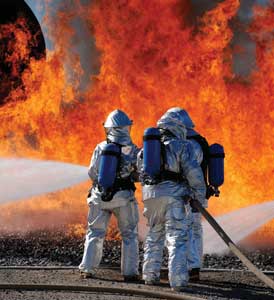By DOUG BAILEY
Fire is a complex phenomenon that requires advanced degrees in chemistry, physics, and engineering to fully understand. Nevertheless, it is important for all firefighters not only to understand the basic principles of fire and heat transfer but also to be reminded periodically of how these principles relate to their line-of-duty responsibilities and their personal safety.
Fires result when fuel, oxygen, and heat come together. When ignition occurs and combustion begins, heat is generated. Smoke, flame, and the release of gases are also products of combustion and are the physical signs that a potentially deadly situation is at hand. As temperatures rise, heat is transferred to the surroundings according to the Laws of Thermodynamics. The second law states that heat will move from hot regions to cooler regions.
Heat transfer happens in three primary ways: conduction (contact), convection (air), and radiation (electromagnetic waves). Understanding how to manage risk associated with heat transfer is paramount to controlling a fire and keeping personnel safe and protected.
Radiant energy is caused by changes to electron configurations within a heated substance. Solids, liquids, and gases that are sufficiently heated will generate radiant energy, which is transported through space from one object to another by waves and is often referred to as electromagnetic radiation (EMR). The warmth felt from the sun’s rays is one example of EMR.
Radiant energy travels in straight lines and can be reflected, absorbed, or transmitted completely through an object. It increases proportionally to flame temperature (by a power of four!), so hotter-burning fires generate significantly more radiation. Close proximity to radiant sources also increases the danger, as smoke particulates and air molecules provide some shielding effect. Thermal radiation is of primary concern, as EMR in these wavelengths can be absorbed by skin and cause burns.
 |
| (1) Photo courtesy of San Bernardino Regional Emergency Training Center. |
Shielding and reflection are the only methods for protecting against the harmful effects of thermal radiation. Shielding generally requires bulky and heavy materials or lots of space and distance. Because first responders are often forced to get dangerously close to radiant sources to save lives and equipment, lightweight proximity suits have been their only choice for nearly 50 years. These suits are designed with metallized outer shells to reflect away safely the majority of radiation. Although gold, silver, and aluminum perform equally as well, aluminum is the universal choice because it is both lightweight and cost effective. Although traditional structural gear provides burn protection and moderate insulation, it absorbs most of the radiant energy it encounters, significantly increasing the overall heat load a first responder experiences, with potentially deadly consequences.
Proximity suits, often referred to as “silvers,” using vacuum vapor deposition (VVD) aluminized thin film laminates on high-performance fabrics, have been in use since the late 1950s. Although there are multiple ways to impart aluminized finishes on high-performance fabrics, only multilayer (two-sided) films laminated using thermoset resins have proven successful in the demanding conditions experienced in proximity firefighting.
For more than 50 years, this technology has proven to be the best choice for creating a highly protective reflective barrier for radiant heat protection in proximity firefighting gear where comfort, light weight, and flexibility matter. Although the reflective protection delivered by silvers is unquestioned, cost concerns and durability associated with the traditional technology, which uses a rubber-based adhesive laminated to a knit fabric, has caused many government and municipal officials to consider alternatives that completely ignore the risk of thermal radiation.
Recent advancements in polymer technology, VVD film processing, and weaving advancements have been purposefully integrated to enhance multilayer aluminized composite outer shells, which greatly improve on the technology that has been relatively unchanged since 1950. Engaging a group of experienced United States manufacturers, Newtex Industries, Inc. led a five-year project to bring together the latest science for this purpose. Leading fiber manufacturers such as PBI Products, Inc. and specialty material experts such as Barrday Advanced Material Solutions worked closely with Newtex engineers and third-party experts to couple the latest film, fiber, and fabric technologies into a silver shell that delivers not only improved durability but also significantly greater protection.
Performance of aluminized outer shells is driven by many factors including, but not limited to, the quality of VVD, adhesive chemistry, durability enhancers, and fabric design. Barrday optimized a revolutionary weave technology and incorporated a PBI fiber to create a new 3-D mock knit fabric ideally suited for Newtex’s Z-Flex® multilayer aluminized process and proximity firefighting. The resulting system, Z-Flex Silver—the first fully integrated proximity outer shell system—delivers increased thermal protection and improved durability without sacrificing comfort, hand flexibility, or freedom of movement.
Author’s note: Z-Flex Silver is component certified to meet the new NFPA 1971-2013 standard.
DOUG BAILEY is the president and global head of business development for Newtex Industries, Inc., where he has served for seven years.

